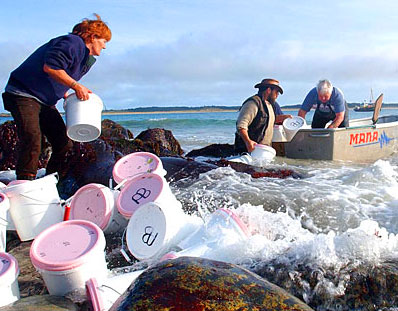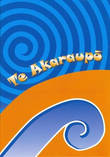Footnotes1. Murihiku => Muri Hiku => Rear Tail => tail end of Maui's canoe => Southland province. 2. Taoka, Takata, Kai Tahu, Kahuraki, Rakatira - this is the South Island pronunciation and spelling for words usually found in Maori dictionaries spelt Taonga, Tangata, Ngai Tahu, Kahurangi and Rangatira. 
3. Rakiura
=> Raki Ura => Rangi Ura => Sky
Glowing => Where there are glowing lights in the
sky => Where you see the Aurora
Australis or Southern Lights => Stewart
Island. Actually until the 20th century the people there
used to pronounce it "Lakiula." 5. Manu, -
We all know "manu" means 'birds,' but here "manu" is
technical shorthand for an extended family's bird harvesting
territory. Each muttonbirding island is divided into a
number of manu, with boundaries defined by
geographic features. Manu are sub-divided into 6. Te Ara a Kiwa - Kiwa's pathway, Foveaux Strait, separating Stewart Island from the South Island. Kiwa was the first navigator to sail around New Zealand. He was here about 800 years ago, and left a few kiore rats behind. When Kiwa arrived there were seabirds nesting in burrows over all the country. About 2 million pairs are still nesting on the rat-free islets off the coast of Stewart Island, and there are remnant nesting sites in some rugged, remote parts of the mainland, but there may have been 100 million nests in pre-human times. The seabirds' inland nesting habits were important in transferring nutrients from the sea to the land. Their nitrogen-and-phosphate-rich excrement, and the remains of eggs, chicks and adults that died ashore nourished the forest ecosystems in which they lived. 7.Names of the muttonbirding islands - There are 36 small islets 500 m to 5 km across, dotted around Stewart Island. The muttonbirding islands listed in this song are mostly in the south-west. The following names have also been listed in newspapers as muttonbirding islands. Entrance Island (Tia), Refuge Island (Herekopare or Marama), Long Island (Kanaiwera or Taukiepa), Moggy Islands (Moki nui and Moki iti), The Breaksea Group (Wharepuaitaha, Rakawhakakura, Kaihuka and Te Pomata kia rehu), Stage Island (Poho o tairea), Bench Island (Te Wahi Taua), Return or Bates Island (Te Moutere o te Wharerimu), First Island (Kane), Codfish Island (Whenua Hou). Timore is south of Stage Island, Te Maka near Easy Harbour, Kai Mohu north of Solomon Island, Putahinu, Huirapa and Te Mai o te Mioka are three islets near Wedge Island. Motunui/Hotunui, Haremai te Raki and Kani te Toi are in the Fancy Group, and Pukeweka is the second islet north of Long Island. 8. Solomon's Island - Horomona (Solomon) Paitu, a convert of Bishop Selwyn and a catechist, was the chief who controlled Rere Whakaupoko. He built a church on it, so that the mutton-birders and seal takers did not neglect their spiritual affairs. 9. Whakatau - a decision or settlement. There has been conflict about manu rights at times. In 1909, an Arowhenua man took action against a man from Bluff for evicting him from Horomamoe Island. Eventually the Native Land Court in 1914 and in 1921 decided the names of those who were entitled to go to each tītī island. 10. Nanao - to feel with the hand and grab. In April the young chicks are still in their burrows, which the parent birds dig to protect their chicks from predatory birds and sealions while they are out at sea catching fish. If the burrow is extra long you have to use a shovel first. 11. Rama - this is the 18th century Tahitian and South Island variant of marama, the moon. However, when the Shearwater chicks come out of their burrows in May to exercise their wings, they avoid predators by exiting only on pitch-dark moonless nights. So rama became the technical term for using artificial "moonlight" to catch them. In pre-electric days, flax-stalks were probably soaked in fat from the cooked muttonbirds and then set alight. You may like to experiment: what is the longest time you can get a torch like this to burn for? 12. Tutua - literally "to be stood together"(?) They were of course cooked first, and the solidified fat, the bag, and the cool autumn temperatures preseverved them. Perhaps tutua is another technical term (?) 13. Poha - The bags for holding the birds are made from bull kelp. The giant sea weed is cut into lengths four feet long and two feet wide. The worker inserts his hand along the inside honey-comb until a bag is formed, with about two inches left unbroken around the edges. The bag was inflated and secured for three days, and then left in a cool place to soften. Flax or totara bark was used as its protective covering. But nowdays the birds are not cooked but salted, and then stored in plastic buckets. 14. Tohu
Raumati - tohu raumati, spelt with
small letters, is "food stores of summer. "Tohu Raumati,
with capitals, is the name of a sacred food
container used to symbolize ownership of the bounty from the
land. Information gleaned from W. A. Taylor (1952) "Lore and History of the South Island Maori"
|




 (Ngati
Kahungunu, Ngati Raukawa)
(Ngati
Kahungunu, Ngati Raukawa)